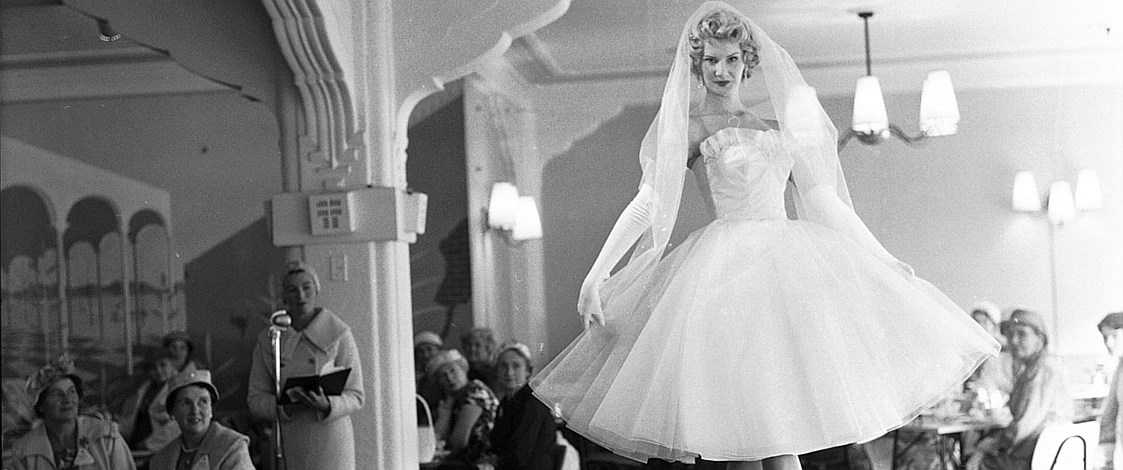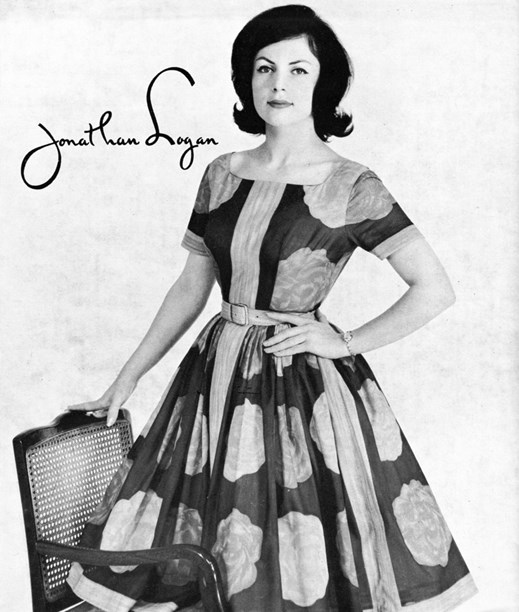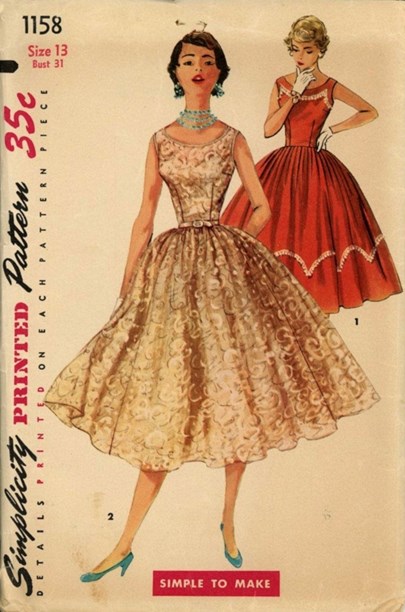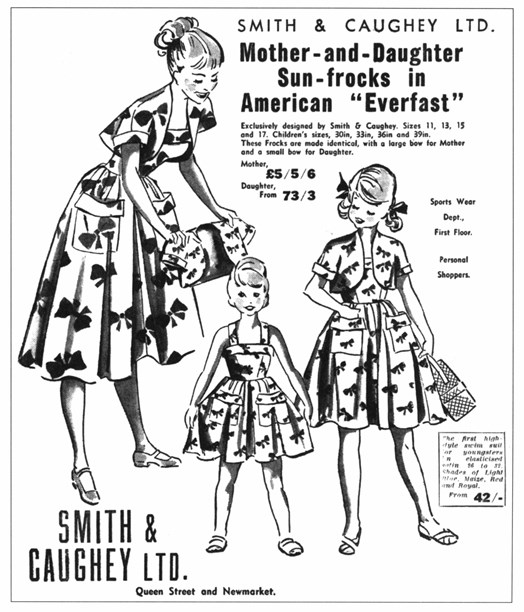Stories
Full Skirts & Wasp Waists
1950s

A symbol of 1950s femininity, the full-skirted, calf-length frock with a fitted bodice remained a New Zealand fashion favourite until the arrival of the mini in 1962. Unlike its curve-conscious counterpart, the sheath dress, which called for a svelte figure or appropriate corseting, the style demanded little of its wearer except, perhaps, a trim waist.
The 'lady dress', as it was sometimes called, derived from Christian Dior’s New Look silhouette. Launched in post war Paris in 1947, the New Look was a luxurious antidote to wartime austerity. It influenced fashion worldwide for more than a decade.
In New Zealand, top-end labels Emma Knuckey, Rosemary Muller and El Jay, who also made Dior originals here under licence, adhered to the couture concept with modifications for the local audience and clothing manufacturers produced less expensive versions of the New Look for the mass market.
While Dior reportedly used 25 yards of material in his voluminous skirts, the yardage used in New Zealand garments was nowhere near that excessive but the new full-skirted style still allowed women to enjoy the pleasurable swish and sway of fabric about their legs.
Here, the New Look evolved into a less formalised way of dressing more aligned with the American lifestyle than the refined elegance of Europe. The pretty dresses had a wholesome Doris Day Down Under appeal that attracted women of all ages, among them a new demographic group called teenagers.

This 1957 advertisement for the Dunedin department store the DSA appeared in the Evening Star, the city’s evening newspaper. It features Betty Barclay printed dresses for teens.
With no dedicated New Zealand fashion magazines in which to seek inspiration, younger women turned instead to American publications such as Mademoiselle and Seventeen. Aimed at college students and career girls, their pages were filled with twirly dresses whose skirts belled out from tiny waists, their volume boosted by multiple petticoats.

A Dunedin dressmaker drafted and made an exact copy of the halter-neck dress on this Seventeen cover for a teenage client in 1957. The dress was white cotton poplin. The red and white spotted cummerbund was made in a softer cotton.
Petticoats that didn’t have the required stiffness were often starched. This laborious process of dipping in starch, drying and ironing to a crisp finish became a pre-party or Saturday night dance ritual for many New Zealand women.
Day dresses had scoop, square, round, bateau, V or halter necks. Collars were confined mainly to shirtwaisters, dresses whose tops resembled a shirt or blouse tucked into the skirt. To draw attention to the waist, a belt was mandatory. Belts and buckles covered with the same fabric as the dress were common. Plain coloured cummerbunds and elastic belts of various widths that fastened in front with a metal clasp were also popular. Another strategy that both helped define the waist and secured the waist seam was to pipe it, sometimes in a plain complementary colour.
There were numerous mass market producers of this fashionable style of dress; Miss Byron, Horrockses, Jaunty Juniors by Roystyles, Jonathan Logan and Betty Barclay were among some of the better known.

Jonathon Logan was an American label targeting the 15 – 25 age group. This dress was made by Promenade Ltd, the label’s New Zealand licensee.
As the design of these dresses was relatively simple, those who lacked the budget to purchase off the rack or wanting an individual look made their own, using Vogue, Butterick, Simplicity or McCall’s patterns. More competent dressmakers would draft their own patterns by studying other garments that inspired them, or pictures in magazines.

1950s Simplicity dress pattern. Patterns were sold alongside fabrics in department stores. Working-girls would line up in their lunch-breaks to peruse the pattern books spread along the counter.
Favoured materials for day dresses and sunfrocks included polished cotton, poplin, satin cotton, Everglaze (glazed chintz) and seersucker. There was a strong preference for prints. Spots, stripes, gingham checks, border prints and graphic or stylised florals all made the cut.

1950s Smith & Caughey advertisement for Mother-and-Daughter Sun-frocks with matching boleros.
In an era when formal balls were part of the social calendar, the 50s’ dress came into its own at night. The sheer volume of taffeta, silk organza, tulle or flocked nylon used in the skirt (calf-length or full length) gave it a balletic quality. Likewise, the fitted bodice which, for evening, tended to be strapless, off-the-shoulder or suspended from tendril-thin straps, was designed to flatter the softness of the female form.
The 1950s is a perennial fashion motif with references and revivals occurring regularly. In 2004, Doris de Pont, Kate Sylvester and Caroline Church from State of Grace were three designers who embraced the vocabulary in their collections.
Doris’ dresses, themed around an ironic artwork by artist Tracey Williams, referenced Wonder Woman. Kate based her collection, 'When Jackson Met Claire', on a hypothetical meeting between two 1950s’ icons, American fashion designer Claire McCardell and the painter Jackson Pollock. Her inspiration came from the discovery of a fabric that reminded her of a Pollock print.
With their bows, heart-shaped buttons, ribbon fastenings and embroidery, Caroline Church’s party dresses and sunfrocks, skirts fluttering to mid-calf, evoked the prom dresses worn in the 1950s by American teens. They were a big hit. Asked in an interview in Style magazine to what she attributed their success, she replied: "50s’ frocks – I always use the word 'frock' rather than 'dress' when referring to the 1950s as it seems more appropriate - had a ladylike feel which is rarely apparent today. Women just want to look feminine again."
The Vintage and Retro scene invariably channels and interprets a romantic and nostalgic view of the 1950s’ aesthetic. Curves are embraced, personal grooming and dressing up are celebrated and the automobiles are shiny and sexy. Beside original vintage garments, there are stores that specialise in reproductions of 1950s fashion in 2017 sizing. Festivals such as the Very Vintage Day Out provide a platform for aficionados and host the Miss Pin Up competition while publications by Glory Days help keep the swing skirt vibe alive.
Text by Cecilie Geary. Banner image of a wedding dress, modelled at a fashion parade in the Wellington department store James Smiths. Image from the Evening Post, courtesy of Alexander Turnbull Library, Wellington, EP/1960/0830-F.
Last published October 2017.